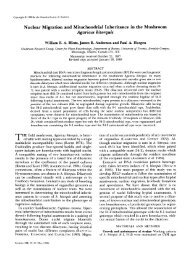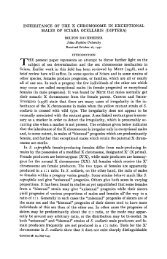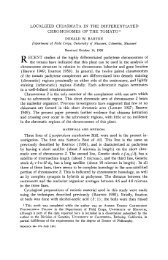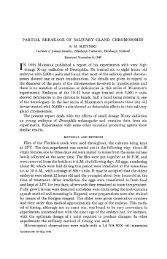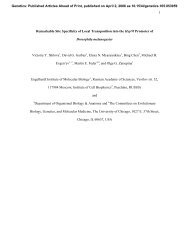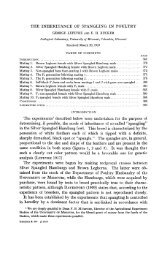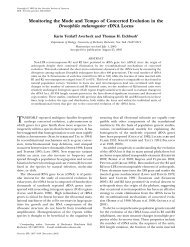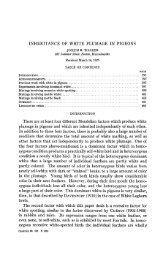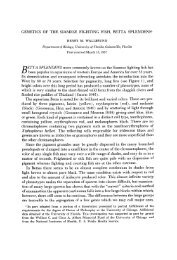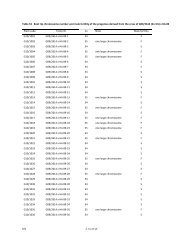abstracts of papers presented at the 1962 meetings - Genetics
abstracts of papers presented at the 1962 meetings - Genetics
abstracts of papers presented at the 1962 meetings - Genetics
You also want an ePaper? Increase the reach of your titles
YUMPU automatically turns print PDFs into web optimized ePapers that Google loves.
ABSTRACTS 94 7<br />
development <strong>of</strong> corn pollen show large differences in <strong>the</strong> number and type <strong>of</strong> endosperm muta-<br />
tions recovered. The most sensitive stage for induced loss <strong>of</strong> endosperm markers is five days<br />
before <strong>the</strong> pollen is shed. This probably corresponds to <strong>the</strong> prophase <strong>of</strong> <strong>the</strong> second pollen mitosis.<br />
One thousand roentgens <strong>of</strong> gamma radi<strong>at</strong>ion given <strong>at</strong> <strong>the</strong> r<strong>at</strong>e <strong>of</strong> 46r/hr <strong>at</strong> this stage produces<br />
twice as many losses <strong>of</strong> marker genes (120 x 10-4) as th<strong>at</strong> delivered <strong>at</strong> ei<strong>the</strong>r four or six days<br />
before pollen shedding. This five day r<strong>at</strong>e is ten times th<strong>at</strong> <strong>of</strong> m<strong>at</strong>ure pollen (radi<strong>at</strong>ed 0, 1, 2, or<br />
3 days before shedding). The genes CZ Sh Bz and Wz in chromosome 9 were studied. Most <strong>of</strong><br />
<strong>the</strong> losses induced involve large rearrangements <strong>of</strong> chromosomes. Only six percent <strong>of</strong> <strong>the</strong> mu-<br />
t<strong>at</strong>ions involve <strong>the</strong> loss <strong>of</strong> but one gene in chromosome 9, one percent <strong>the</strong> loss <strong>of</strong> two genes,<br />
20% <strong>the</strong> loss <strong>of</strong> three genes, and 73% <strong>the</strong> loss <strong>of</strong> all four genes being studied. The chromosomal<br />
type losses begin increasing <strong>at</strong> about 15 days before pollin<strong>at</strong>ion. Chromosomal losses from radi-<br />
<strong>at</strong>ion given earlier than 15 days before pollin<strong>at</strong>ion are about twice <strong>the</strong> control r<strong>at</strong>e and <strong>at</strong> five<br />
days are about 100 times <strong>the</strong> control. Eleven mut<strong>at</strong>ions for single genes which showed no<br />
evidence <strong>of</strong> sterility have been recovered from radi<strong>at</strong>ion given between 19 and 13 days before<br />
m<strong>at</strong>ure pollen. These were most likely induced after meiosis and before <strong>the</strong> first pollen mitosis.<br />
We have also recovered four “gene” type mut<strong>at</strong>ions from m<strong>at</strong>erial radi<strong>at</strong>ed before meiosis. One<br />
thousand roentgens <strong>of</strong> gamma radi<strong>at</strong>ion given <strong>at</strong> <strong>the</strong> r<strong>at</strong>e <strong>of</strong> Mr/hr during <strong>the</strong>se stages produced<br />
shrunken “gene” type mutants <strong>at</strong> <strong>the</strong> r<strong>at</strong>e <strong>of</strong> 53 x 10-6. The control r<strong>at</strong>e is about 2 x 10-6.<br />
CENTER, E. M., Stanford University School <strong>of</strong> Medicine, Stanford, California: A comparison<br />
<strong>of</strong> some ter<strong>at</strong>ogenic effects in mice.-Since finding th<strong>at</strong> nitrogen mustard (HN, form) is<br />
effective as a ter<strong>at</strong>ogenic agent (DANFORTH and CENTER, Proc. Soc. Exptl. Biol. Med. 86:<br />
705, 1954) o<strong>the</strong>r chemicals have been investig<strong>at</strong>ed in this regard. Beyond a few vascular<br />
changes, it is doubtful th<strong>at</strong> any definite morphological abnormalities occurred among a<br />
limited number <strong>of</strong> embryos tre<strong>at</strong>ed in utero with Feulgen solution. Following propyl-thiouracil<br />
tre<strong>at</strong>ment <strong>of</strong> 35 pregnant females, it was also difficult except in five litters to estim<strong>at</strong>e whe<strong>the</strong>r<br />
any definite effects were resultant. In comparison with HN, this is seemingly a rel<strong>at</strong>ively ineffective<br />
agent.-Recently, experiments were begun with nitrosoguanidine, this chemical is, like<br />
HN,, reasonably efficient <strong>at</strong> inducing abnormalities. Perhaps this can be best indic<strong>at</strong>ed by comparkg<br />
<strong>the</strong> results <strong>of</strong> <strong>the</strong>se two agents. Although it should be emphasized th<strong>at</strong> strain differences<br />
in response and vari<strong>at</strong>ions in severity <strong>of</strong> tre<strong>at</strong>ment may call for some qualific<strong>at</strong>ion <strong>of</strong> compar<strong>at</strong>ive<br />
st<strong>at</strong>ements, it seems evident th<strong>at</strong> nitrosoguanidine has a more pronounced effect on <strong>the</strong><br />
earlier embryonic stages <strong>of</strong> seven, eight, and nine days than HN,. On <strong>the</strong> o<strong>the</strong>r hand, <strong>of</strong> <strong>the</strong> two,<br />
HN, has an apparently gre<strong>at</strong>er effect on developing embryos on days 13, 14, and 15. While<br />
effects resulting from both chemicals include edema, vascular changes, eye defects, abnormal<br />
tails, and digital abnormalities, nitrosoguanidine tends to reduce in size all elements <strong>of</strong> <strong>the</strong> foot<br />
whereas HN, tends to suppress completely <strong>the</strong> development <strong>of</strong> one or more individual digits.<br />
CHAPIN, MARGARET,<br />
and G. R. DUBES, University <strong>of</strong> Kansas School <strong>of</strong> Medicine, Kansas City,<br />
Kansas: Adenine-resistant mutant <strong>of</strong> poliovirus.-In 1957 and 1961 we reported cystine-response<br />
(CT) mutants and tryptophan-requiring (tr) mutant <strong>of</strong> poliovirus, respectively. Now we report<br />
an adenine-resistant (ad) mutant, which was selected by 14 passages, starting with wild-type<br />
Brooks virus, on monkey kidney tissue cultures under medium containing 3 miv adenine, a<br />
concentr<strong>at</strong>ion strongly inhibiting wild-type virus but not markedly cytotoxic.-Plaque produc-<br />
tion by mutant is slightly inhibited and r<strong>at</strong>e <strong>of</strong> appearance <strong>of</strong> progeny virus from it is dimin-<br />
ished slightly by 3 miv adenine; by both <strong>the</strong>se criteria wild type is strongly inhibited. Adeno-<br />
sine (5 mix) and adenosine-5’-phosphoric acid (4 miv) similarly differenti<strong>at</strong>e between mutant<br />
and wild type, though <strong>the</strong>y are less inhibitory than adenine. Nei<strong>the</strong>r wild type nor mutant is<br />
inhibited by high concentr<strong>at</strong>ions <strong>of</strong> guanine (1 miv), cytosine (12 miv), uracil (6 mix), or<br />
thymine (9 miv) . Surprisingly, mutant is cystine-nonrequiring, in contrast to cystine-requiring<br />
wild type. Th<strong>at</strong> an adenine-resistant virus need not necessarily be cystine-nonrequiring was<br />
shown by selection <strong>of</strong> a cystine-requiring mutant (still adenine-resistant) by eight passages,<br />
starting with ad mutant, on 30” cultures under medium with 1 mM L-cystine and,3 mM





